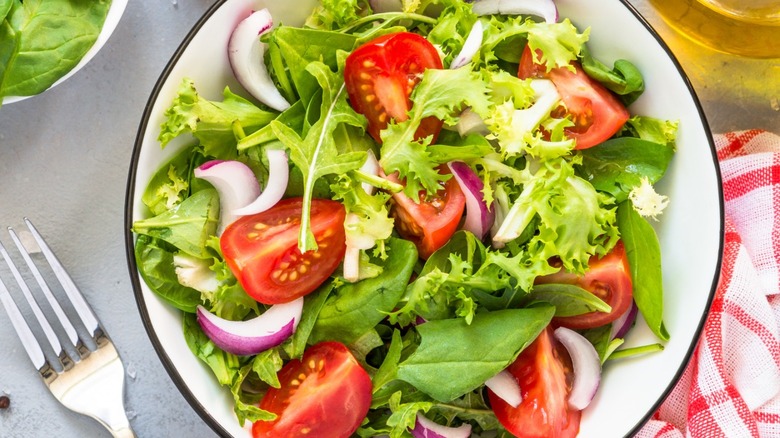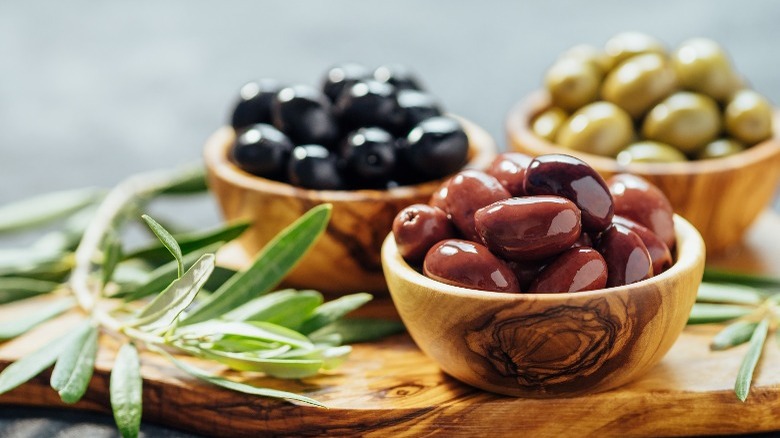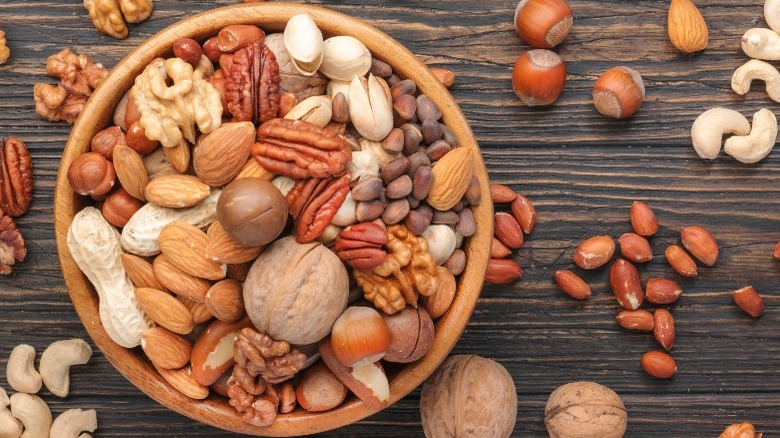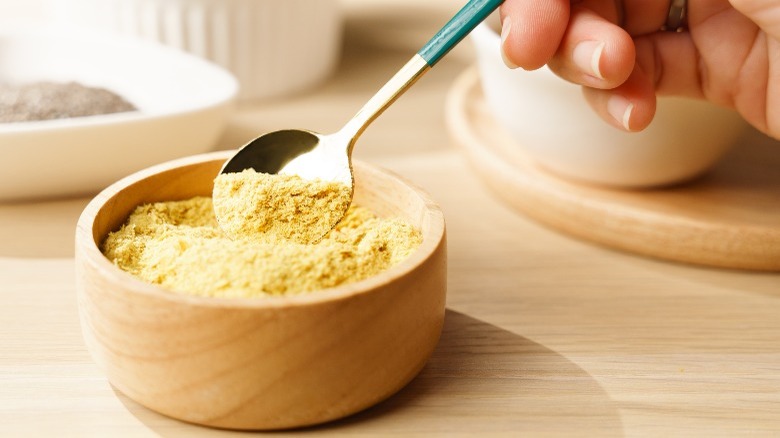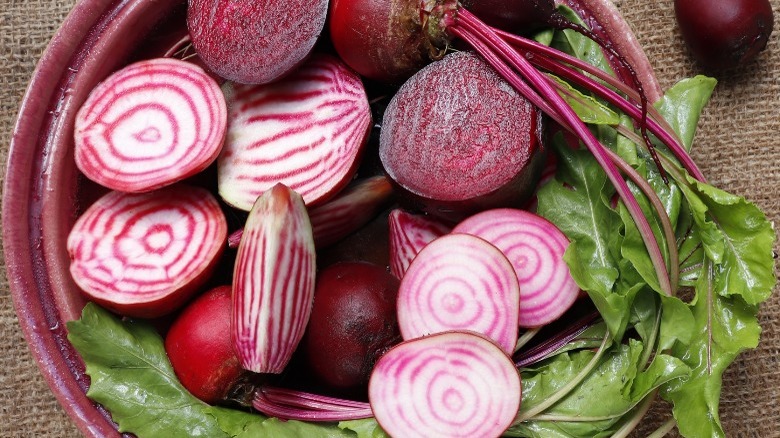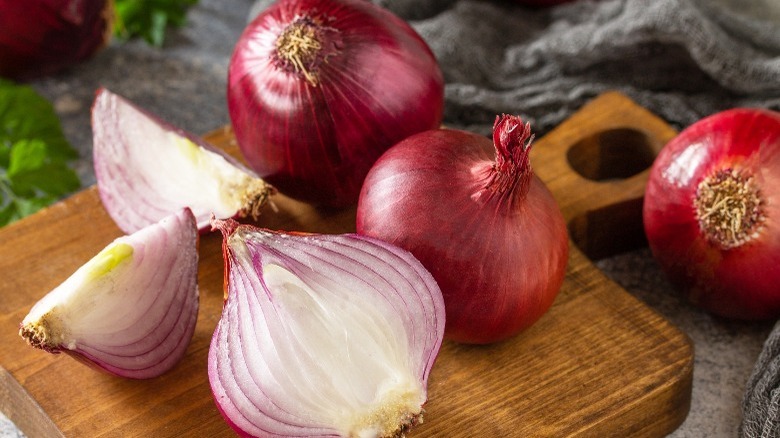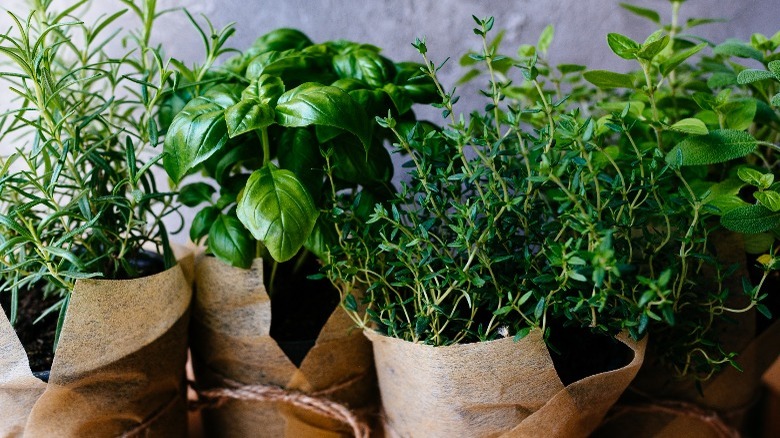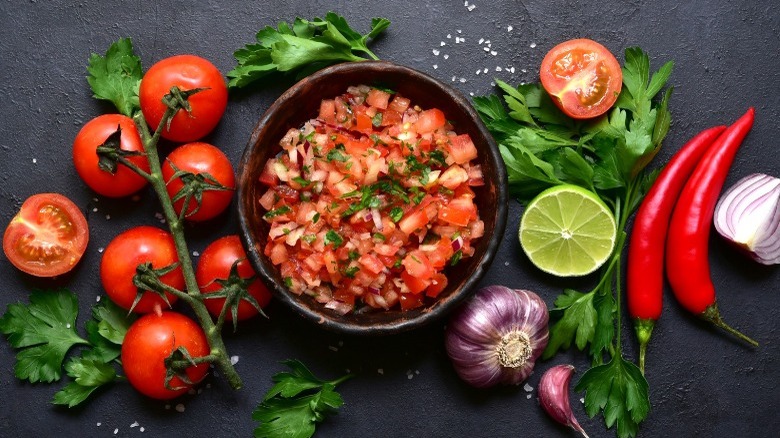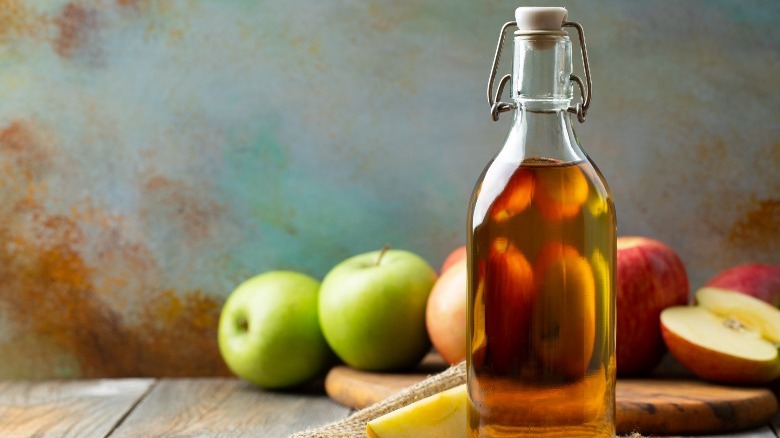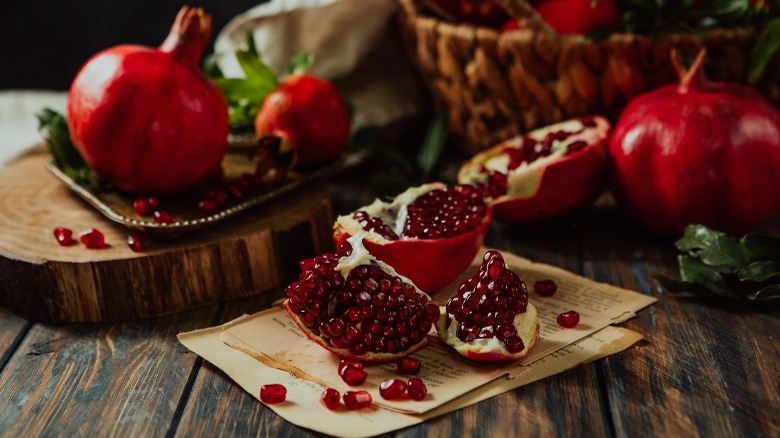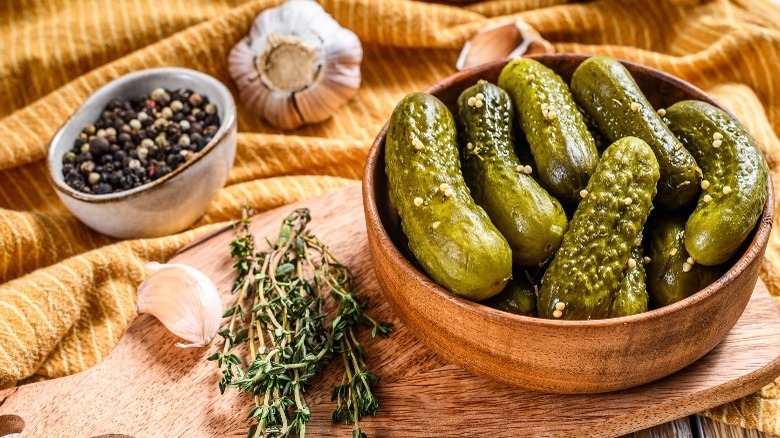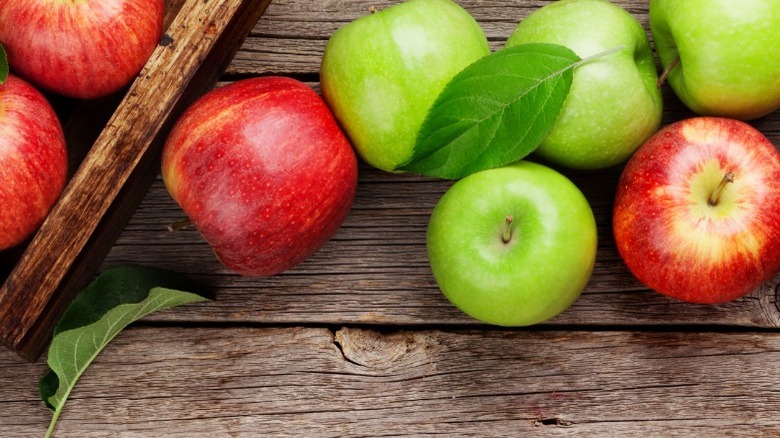15 Things You Should Be Putting On Your Salad But Aren't
Salad has long been saddled with a reputation as a boring dinner guest, a bowl of rabbit food that needs to be drowned in dressing to even be palatable. If salad were an algebra problem, it would probably be something simple like lettuce + vegetables + dressing = meh. The mental image conjured up by diners who eschew salad is usually the diner-style dinner starters that feature a handful of iceberg lettuce, fourteen carrot shreds, and a few pale tomato slices. That isn't anyone's idea of a good time.
The truth is, salad is a culinary shapeshifter, an experiment in mad kitchen science that can be a thousand delicious things if you use your imagination. Switch out the iceberg for romaine, red lettuce, or arugula! Get wacky and throw some kale into the mix! Chop up whatever fresh veggies you can think of and throw a garden party right in your bowl. Once you have the basics down, your salad can be just about anything you want it to be. The magic is in the add-ins. If you've never tried supercharging your salad with crunchy, salty, sweet, or zesty elements, then have you even had a salad? Here's a list of 15 things you've probably never thought to add to your salad but should immediately consider. Not to brag, but you're in for the salad of your life.
Olives
These healthful gems aren't just for the relish tray or charcuterie board anymore. Their toothy texture and salty flavor lend a much-needed boost to the monotony of the standard salad greens and veggies. That's right ... technically speaking, olives aren't a vegetable; they're a fruit, with health benefits that include antioxidants and a powerful dose of vitamin E.
A trip to the olive section of the grocery store will tell you there's a vast array of olives to choose from when revamping your salad options. With Spanish, pimento-stuffed, black, kalamata, with pits and without, olive-picking can be a sticky wicket. Black olives aren't known for their dynamic flavor and are best saved for pizzas and Thanksgiving spreads. Kalamata olives, named for the Greek town that first grew the sun-loving fruit, are a favorite salad topper around the internet. "Kalamata olives are great, strong flavor but not a sharp bite," notes one Quora user. The pitted version are the hands-down winner, for ease of use as well as for ready flavor.
Seeds and Nuts
The always-healthy selection of seeds and nuts that add crunch and flavor to your salad is practically never-ending. Sunflower seeds are an obvious addition, having made the grade at salad bars and self-serve buffets. Not only does their mellow flavor play nicely with just about everything else in your salad, but for being the smallest item in the mix, they're a health food dynamo, offering vitamins, minerals, and healthy polyunsaturated fats in every serving. Chia seeds are another smart option, and not just for growing on the ever-popular Christmas gift, the Chia Pet. Chia seeds provide the highest omega-3 fat content of all plant foods, and they're considered a complete protein, which means they contain all the essential amino acids needed for muscle synthesis.
Nuts of all sorts are the tops when it comes to salad toppers, treasured for their range, versatility, and nutritional wow factor. Whether you go for roasted almond slivers, toasted pecans, dry-roasted peanuts, or raw walnuts, you'll be getting more than just an earthy bite of flavor among the garden greens. You'll also be getting protein, polyunsaturated fats that are great for your heart and brain, and a load of minerals.
Nutritional Yeast
If you've never heard of this shakable salad topping, add it to your grocery list for your next salad opportunity. While it may sound a bit questionable, nutritional yeast — or nooch, as the health food set lovingly refer to it — is derived from "a species of yeast known as Saccharomyces cerevisiae," according to Medical News Today. It's heated and dried, which makes it inactive and prevents fermentation.
So how does it improve a salad? The flavor of nooch is described as "cheesy," which makes it highly popular as a vegan popcorn topping, though you probably won't mistake it for parmesan. As a salad topping, a sprinkle or two can add complexity to the green flavors of your lettuce and veggie medley. It can also be used as an ingredient in healthy salad dressings, as well as being pulsed in the blender with sunflower seeds and garlic powder to create a shakable topping with a bit more body.
Beets
With their vibrant violet flesh and even more intensely colored juice, beets are maybe the most colorful addition you can make to a salad. They provide a whopping 23 grams of magnesium and 40 grams of phosphorus per 3-ounce serving and may assist with health benefits ranging from lowering blood pressure to preventing cataracts.
Though beets are traditionally thought of as a base ingredient for borscht and other soups, slices of roasted beets can dress up a salad nicely. A Reddit user playing culinary detective to figure out the prep process of a particular beet salad they'd eaten offered their best take as roasting "already sliced beets at 400 degrees F for 10 minutes without oil." Raw beets can also be added to salads in either slices or shreds. Whichever way you prefer them, be cautious with your prep; beet juice is often used as an all-natural plant-based dye and stains can wreak havoc on your favorite apron.
Onions
The powerful aromatic magic of onions in all forms make them a natural addition to a salad in need of a kick in the greens. Their mighty aroma may be enough to keep you at a distance, but you'll be living the good life from all the health benefits onions offer. One flavonoid in particular, quercetin, is an antioxidant that may have heart and cancer-preventing benefits. Adding helpful phytochemicals to an already healthful combination of plant-based nutrients is like the icing on the cake, if the cake was lettuce and the icing was onion-flavored.
If you're not afraid of the strength in their oniony odor, a red or white onion sliced into rings is a spicy plus in your salad. A yellow onion may be a bit sweeter and can be caramelized for a sweet treat. If you find the bombastic flavor too much to take, you can follow a Reddit user's advice to "soak the onions in cold water for abt 15 minutes to decrease its pungency." And if that doesn't do the trick, you can always opt for milder green onions or scallions in your salad instead.
Herbs
You can never have to many greens in your greens, and that includes the broad selection of herbs you can add on top. Herbs like cilantro valued for their healthful compounds that can help battle inflammation, provide antifungal protection, and can even help in fighting cancer. Basil is another flavorful herb that can jazz up a salad while offering health benefits like helping with digestion and keeping your skin glowing naturally. Mint and its immune-boosting magic can also find a home in the salad bowl, though they're traditionally thought of as a sweeter herb from their use in candy and sweet flavorings. Because fresh versions are usually found in the refrigerated produce section of most grocery stores, herbs are an easy ingredient to pick up for adding to your home salad green scene. Some herb fans even recommend them as an inexpensive way to flavor up salads when you're shopping on a budget.
Salsa
What is salsa if not chopped vegetables and spices? In its most basic form, salsa is a blend of tomatoes, peppers, onions, and seasonings — all things you were probably going to put in your salad anyway. So why not skip the dressing with its extra calories and bring a little fire to the table with a salsa dressing instead? Your salad doesn't have to be a taco salad, either; salsa in just about any version will show your salad fixings a saucy good time, whether it's a simple Romaine affair or a full-blown spring green situation. If you're so inclined, you can throw fresh veggies in a blender and pulse them into a salsa dressing that's too fresh to resist. And if you opt for bottled salsa, be sure to check the label to find one with as little added sodium and sugar as possible. There's no reason to ruin a healthy salad with a salsa that didn't read the assignment.
Apple Cider Vinegar
A welcome tart and tangy addition to any salad dressing, apple cider vinegar is the base for many homemade dressings with surprising health value. As the name states pretty clearly, this vinegar is made from fermented apples, which results in a cloudy combination of yeast and bacteria called the mother. The mother is a probiotic, which makes it a power player in the eating-for-health game. Apple cider vinegar even shows up as a health supplement in pharmacies and vitamin shops, in the form of gummies, which should definitely not be part of your salad recipe.
Though an apple cider vinegar dressing offers a wealth of benefits from potential weight loss to blood sugar control, it is definitely an acid, and eating too much of it can cause problems. As Reddit users point out, it's best balanced out in a dressing with olive oil and sweetened with a little honey.
Pomegranate Seeds
A crunchy burst of tangy sweetness is sometimes just what your salad needs, and pomegranate seeds stand ready to heed the call. These little gems are another deceptively small power food that bring antioxidants to the nutrition party like nobody's business. Their antioxidant compounds can help lower bad cholesterol and prevent damage to cells, with a whole pomegranate providing almost half your daily required dose of vitamin C. That may seem like a lot of seeds, but their size makes them easy to sprinkle all over your salad dish. They can even become the star of the show, as in a pomegranate salad recipe one Reddit user calls "The pomegranate salad that gives me a reason to live." Quite a testimonial.
The sweet-and-tart nature of pomegranate seeds makes them a great addition to a spinach salad. They play nicely with a soft cheese topping like feta or goat cheese and make an interesting counterpoint to walnuts or pecans.
Pickles
The unexpected zing and weird, wiggly crunch of pickles can turn a simple salad into a celebration of life. Sure, they're a natural fit on any burger, and sometimes on hotdogs in the form of relish. But dropped on top of a green salad, pickles become a revelation that you may never be able to live without. One Reddit user was either so surprised or so impressed with their significant other's addition of pickles on their salad, they were inspired to post a photo. Response from commenters was largely positive.
Another Reddit user urged readers to add pickles to salads, pointing out that "It makes this whole healthy eating thing feel somewhat flavorful." To be fair, pickles come with a lot of sodium; 3 dill chips contain 210 milligrams, which is almost 10% of the daily recommended allowance. So if pickles are the only salty element you intend to add to your salad, you have some wiggle room. If they'll be sharing the plate with other sodium-rich ingredients, maybe go a little easy.
Apples
Not everyone agrees that slices of crisp, juicy apples are at home on top of a salad. Some Reddit users had strong opinions when asked about mixing fruit and green salad ingredients. The consensus: fruits like tomatoes, cucumbers, and avocados can stay, but everything else is taboo. The idea of sweet and savory blending in a salad seems to be a hotly contested suggestion.
For the brave of tongue willing to venture an attempt, a tart green apple in slices or shreds can add mouthwatering flavor to a salad in need of a little oomph. A sweet apple like a Honeycrisp or a Gala can bring sweetness to greens on the bitter side like arugula or kale. Texture may be part of the trick, too; in another Reddit thread, commenters suggest a combination of "apple, fennel, and carrot" atop spring greens, which sounds like a tasty and crunchy lunch or dinner salad.
